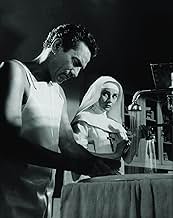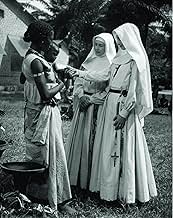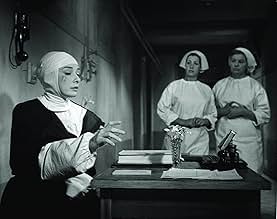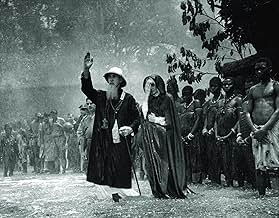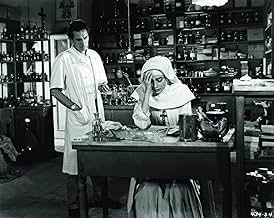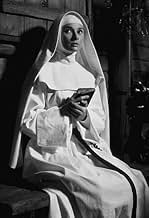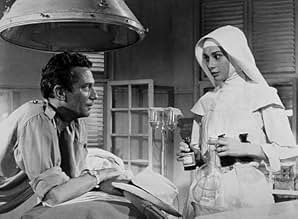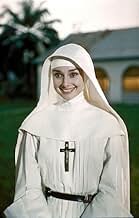Après avoir quitté une riche famille belge pour devenir religieuse, Soeur Luke lutte avec son dévouement à ses voeux pendant la crise, la déception et la Seconde Guerre mondiale.Après avoir quitté une riche famille belge pour devenir religieuse, Soeur Luke lutte avec son dévouement à ses voeux pendant la crise, la déception et la Seconde Guerre mondiale.Après avoir quitté une riche famille belge pour devenir religieuse, Soeur Luke lutte avec son dévouement à ses voeux pendant la crise, la déception et la Seconde Guerre mondiale.
- Réalisation
- Scénario
- Casting principal
- Nommé pour 8 Oscars
- 11 victoires et 23 nominations au total
- Rev. Mother Emmanuel (Belgium)
- (as Dame Edith Evans)
- Mother Mathilde (Africa)
- (as Dame Peggy Ashcroft)
Avis à la une
Anyone who has tried to live a perfect life, to please God and never offend Him with sins of any nature, knows it is impossible. It is a noble pursuit, but an exercise in futility that can lead to utter frustration. That is the dilemma we witness here in this film through the life of a well-meaning and sweet-as-can-be Belgian lady: "Gabrielle van der Mal" who is renamed "Sister Luke" after completing her training as a nun in the 1930s. Audrey Hepburn is superb as this woman, who has the greatest of spiritual intentions and a heart not only for God but to be a great nurse and follow in her father's footsteps, a famous physician in his country.
Can't she be both? The answer, of course, is "yes," but that's not the answer she receives periodically at the convent, or interprets because she's so tough on herself, and it causes great inner conflict.
Hepburn doesn't have tons of dialog in here and doesn't require it. The different looks on her face during this long story, especially when there is disappointment, are priceless. They are so subtle, but so telling. I am one who would vote for this film as Audrey's best performance, which is saying a lot.
Director Fred Zinneman struck a correct balance of fine pace and sensitivity in the mesmerizing tale of a young Belgian girl who becomes a religious missionary and is sent to the Belgian Congo to work at a hospital . Finely starred by a luminous Audrey Hepburn as a dedicated nun who subsequently comes to question her vocation , as she is struggling to reconcile her free spirit and philanthropic wishes with the religious rigors ; Hepburn chalked up another hit in this long but always interesting flick based on Kathryn Hulme's novel , being rightly adapted by screenwriter Robert Anderson . Spectacular settings and well staged scenes , in fact , members of the Rome Opera ballet corps were hired to play some of the nuns, and complex convent rituals were literally choreographed for them . This agreeable flick packs an exciting screenplay , thought-provoking drama , fine interpretations and intelligent filmmaking . It's surprising that the movie didn't achieve any of the six Academy Award for which it was nominated ; however , it won NY Film Critics to best actress and director and British Academy gave prizes to best actress and support cast . Casting is frankly well . Good acting by Audrey Hepburn as a beautiful missionary nurse who gains the trust of the locals , not only providing medical care but dealing with African people ; this was one of Audrey Hepburn's favorite of her films and it was also one of her most financially successful . Excellent Peter Finch as a good surgeon , he doesn't quite hit it off with Gabriella at first but soon starts to develop deep affections for her . Furthermore , a nice support cast formed by notorious secondaries such as Edith Evans , Peggy Ashcroft , Dean Jagger ,Beatrice Straight ,Rosalie Crutchley , Ruth White , Barbara O'Neil , Lionel Jeffries , Colleen Dewhurst and Niall MacGinnis , among others . ¨Nun's story¨ consolidated a sub-genre about nuns or religious people in far countries , going on ¨Heaven knows , Mr Allison¨ by John Huston with Robert Mitchum Deborah Kerr , ¨The Sins of Rachel Cade¨ also produced by Henry Blanke and directed by Gordon Douglas with Angie Dickinson , Roger Moore and Peter Finch , too , and ¨A Nun at the Crossroads¨ with Rosanna Schiaffino and John Richardson , among others.
Appropriate as well as sensitive musical score by the classic Franz Waxman . Glamorous and evocative cinematography by Franz Planer , though mostly filmed on real African exteriors , in fact , the film was shot on location in Rome, Bruges, Stanleyville and a real leper colony in the Congo . The motion picture well produced by Henry Blanke was stunningly directed by Fred Zinneman. This is one of various and pleasant works , some major and minor successes of his long career as a filmmaker . He was a Hollywood veteran director, directing early movies and a long career until the 80s . With ¨The nun's story¨ Zinnemann chalked another major hit in this overlong but always absorbing tale . After acquiring the rights to Kathryn Hulme's bestselling novel, Fred Zinnemann found that no one in Hollywood had any enthusiasm towards turning it into a film, citing it as being devoid of action , but all that changed when Audrey Hepburn expressed a desire to take the lead role . Rating : 8 , Above average , well worth seeing .
anyone who thinks she was only a fashion model is well advised to see this film. I first saw it in a theatre, in 1959. I went in about five minutes before the end--and the theatre was completely sold out. At the end of the movie, no one moved--everyone remained seated for about thirty seconds. Then the audience got up and filed out--without a single sound. I stayed through to see the ending again. The audience behavior was the same. I have never seen an audience reaction like this.
Hepburn should have received an Oscar for this performance, as well as another for "Two for the Road," for which she wasn't even nominated. She has been sadly underrated and undervalued as an actress. Her high placement in many Best Actress Ever polls has been entirely justified and very pleasing.
Audrey Hepburn - sans makeup and the kind of fashion-plate wardrobe that had already become the hallmark of her movie career - delivers one of her richest performances as the strong-willed and fiercely independent Sister Luke, whose very psyche is torn asunder by the battle between her own innate, personal pride and a sincere desire to live a life of obedience to the Church and its rules. With everything but her countenance hidden beneath a nun's habit, Ms. Hepburn is forced to draw on her resources as an actress, having to convey the titanic internal conflict taking place within her character almost entirely through facial expressions, vocal intonations and body language. And she proves herself more than equal to the challenge. She is brilliantly complemented by Peter Finch, playing the cynical but humane Dr. Fortunati, a dedicated surgeon who is as concerned about Sister Luke's spiritual health as her physical health. The relationship between the two is handled with a great deal of subtlety and tact, never allowing the obvious romantic attraction between the two attractive people to come too much to the fore. Rounding out the excellent cast are Dean Jagger as Gabrielle's loving and concerned father, Peggy Ashcroft and Mildred Dunnock as two older nuns who help guide Sister Luke along the way, and the incomparable Edith Evans, simply astounding as the Reverend Mother who sees unwavering devotion to God and the Church as the one and only goal of a serious nun.
Among other things, "The Nun's Story" is that rare film dealing with religion and spirituality that doesn't contain a single hokey or sentimental moment, that knows the difference between religion and religiosity, that is respectful without being unduly reverential, and that acknowledges the complexity of the human heart in matters of devotion and faith. It also is not afraid to take its time to set the scene and tell its story, never feeling the need to rush headlong into the next dramatic moment just to keep the movie going. In a perfect blending of form and content, the film is every bit as thoughtful, subtle and contemplative as its subject matter, its mood greatly enhanced by the rich and beautiful Franz Waxman score that underlines the seriousness of the work.
In addition to all its other fine virtues, "The Nun's Story" features one of the greatest final scenes and closing shots in motion picture history, a masterpiece of precision and understatement that demonstrates the kind of taste Zinnemman always displayed as a director. The movie is made up of small, beautifully observed moments that, when put together, provide a powerful glimpse into the heart and life of a fascinating, caring individual who wants to do great things in the world but who realizes that the path she has chosen is not the one that will ultimately lead her to her rightful destiny.
On every level of film-making, this is truly one of the greats.
This is an utterly fascinating story of a young nun (Audrey Hepburn), and a non-believing doctor (Peter Finch). Sister Luke (Hepburn) is constantly challenged in sticking to her vows, especially the one of obedience.
She chaffed at the rules that did not leave room for common sense. Is it better to strictly obey or to do more good in disobedience? It is a question asked over and over.
Things become more difficult as WWII starts. Now, the rules must be set aside to help the war effort. Eventually, the conflict between the rules and her need for independence is resolved.
Hepburn was fantastic, as was Finch. Well worth seeing.
Le saviez-vous
- AnecdotesThe role of Sister Luke was suggested for Ingrid Bergman but Bergman herself said she was too old for the role and instead proposed Audrey Hepburn.
- GaffesWhen the patient in the Congo hospital is being attended by several people, the voice of the actor playing the patient is obviously dubbed over by actor Dean Jagger, who plays Sister Luke's father in the film.
- Citations
Sister Luke: You can cheat your sisters, but you cannot cheat yourself or God.
Rev. Mother Emmanuel: Have you struggled long enough to say surely that you've come to the end?
Sister Luke: I think I've been struggling all these years, Reverend Mother. In the beginning each struggle seemed different from the one before it. But then they began to repeat, and I saw they all had the same core: obedience. Without question, without inner murmuring. Perfect obedience as Christ practiced it. As I no longer can.
Rev. Mother Emmanuel: Yes?
Sister Luke: There are times when my conscience asks which has priority. It or the Holy Rule? When the bell calls me to chapel, I often have to sacrifice what might be the decisive moment in a spiritual talk with a patient. I'm late every day for chapel or refectory or both. When I have night duty I break the Grand Silence because I can no longer cut short a talk with a patient who seems to need me. Mother, why must God's helpers be struck dumb by five bells in the very hours when men in trouble want to talk about their souls?
- ConnexionsFeatured in Dis-donc, papa: Testing Time (1990)
- Bandes originalesVoi Che Sapete
from "The Marriage of Figaro"
Written by Wolfgang Amadeus Mozart (as W. A. Mozart)
Played by Gabi and her father on the piano, and recurring throughout the film's score.
Meilleurs choix
Détails
- Date de sortie
- Pays d’origine
- Langue
- Aussi connu sous le nom de
- L'histoire d'une nonne
- Lieux de tournage
- Brugge, West-Vlaanderen, Belgique(Convent exteriors, other exteriors)
- Société de production
- Voir plus de crédits d'entreprise sur IMDbPro
Box-office
- Budget
- 3 500 000 $US (estimé)
- Durée2 heures 29 minutes
- Couleur
- Rapport de forme
- 1.85 : 1


